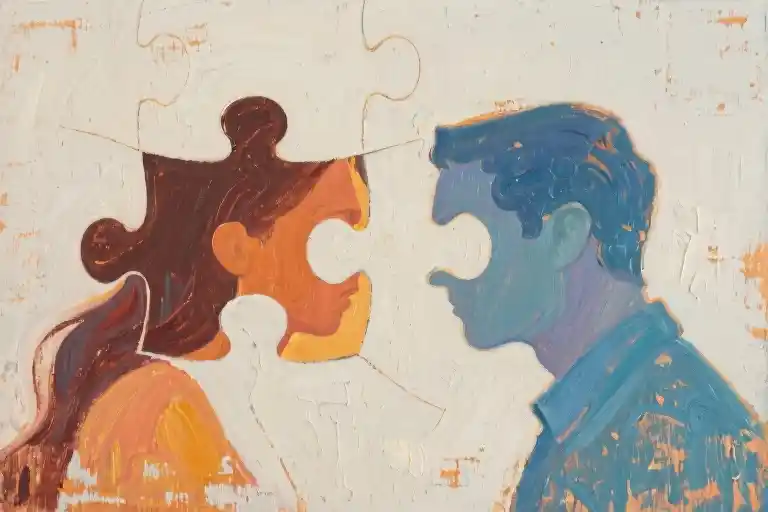The April sunlight falls across my desk at the same angle it did twelve months ago when I signed the divorce papers. There’s something quietly archaeological about this moment – like brushing dust off a personal artifact that simultaneously feels ancient and startlingly fresh.
This month marks my first full trip around the sun as a legally single woman after twenty consecutive years of coupledom. The realization makes my fingers pause over the keyboard. Twenty years. That’s longer than some of my coworkers have been alive. Longer than the lifespan of my first car. Nearly as long as the entire Harry Potter franchise from first book to final film.
We need new measurement tools for emotional timelines like these. The standard calendar feels inadequate when examining relationship strata that accumulated over decades. Hence my makeshift “emotional archaeology” kit – part journal, part therapy notes, part linguistic time machine to revisit past selves with present-day vocabulary.
Here’s the central excavation site: Can we ever properly understand our own relationship histories while we’re still living them? Like trying to read a book pressed against your nose, the meaning only clarifies with distance. Those scribbled diary entries from 2003 make very different sense through 2023 lenses, especially now that we have terms like situationship to describe gray-area connections that previously left us grasping for language.
My personal dig site reveals consecutive layers:
- 1 year of post-divorce sediment
- 15-year marriage stratum
- 5-year courtship deposits
- A startlingly thin 2-week volcanic ash layer between relationships
- Earlier, pre-coupling bedrock where fossilized teenage anxieties remain perfectly preserved
The most revealing artifact? That frantic two-week intermission between long-term partners – barely enough time to do laundry between relationships, let alone process anything. At the time, this felt normal. Now it reads like emotional dependency preserved in amber.
Modern relationship terminology functions like carbon dating for these discoveries. That ambiguous summer fling from college wasn’t a “failed relationship” after all – it was a textbook situationship. Those confusing mixed signals from a coworker in my twenties? An emotional situationship with workplace complications. Having these labels now feels like being handed corrective lenses for memories that always looked slightly blurry.
Perhaps this is what healing after divorce actually looks like – not moving on, but moving backward with better tools. Not forgetting, but finally understanding. As I begin this emotional excavation project, I keep wondering: How many other misinterpreted moments in my relationship history might reveal new truths when examined through contemporary frameworks? And what might we all discover if we applied this same archaeological patience to our personal love stories?
Geological Report: 20 Years of Emotional Sediment
Core Sampling Documentation (Timeline Visualization)
The strata of my relationship history reveal a startling continuity when examined under the microscope of retrospection. Dating back to 1998, the core samples show uninterrupted emotional layers spanning:
- 3.2 years of pre-marriage courtship with Partner A (1998-2001)
- 2 weeks of atmospheric disturbance (August 2001)
- 5.5 years of pre-marital crystallization with Partner B (2001-2006)
- 15 years of marital metamorphosis (2006-2021)
- 1 year of post-marital weathering (2021-present)
This cross-section exposes what relationship scientists call serial monogamy compression – the phenomenon where individuals transition directly from one committed relationship to another without tectonic plates of solitude shifting between them. My personal seismograph registered only 14 days of emotional stillness across two decades.
Anomalous Stratum Analysis (The Significance of Two Weeks)
That thin, almost imperceptible layer from August 2001 warrants special examination. At 0.08% of my adult relationship timeline, this brief intermission between partners represents either:
- A healthy display of emotional resilience (“She processed a breakup efficiently!”)
- A troubling indicator of attachment anxiety (“She couldn’t tolerate being alone!”)
Contemporary relationship archaeology suggests this micro-stratum reveals our generation’s emotional capitalism – the unconscious belief that unattached time constitutes wasted productivity in the romance market. The sediment contains high concentrations of:
- Restlessness particles (3 failed attempts to call Partner A)
- Validation-seeking fossils (5 hastily arranged “practice dates”)
- Social comparison debris (12 envious observations of coupled friends)
Dependency Fossil Identification (Biomarkers of Continuous Connection)
Laboratory analysis of my relationship strata detected persistent organic compounds:
- Oxytocin residues: Present in consistent concentrations across all layers, suggesting continuous physical intimacy
- Routine crystallization: Regularly spaced dinner/movie/vacation deposits indicating habit formation
- Identity fusion minerals: Gradual erosion of “I” statements and proliferation of “we” formations
Most revealing are the transition fossils between relationships – those preserved moments where the emotional ecosystem remained intact despite species turnover. The same:
- Sunday morning routines
- Inside joke repositories
- Conflict resolution patterns
persisted across different partners, like ferns surviving mass extinctions.
This core sample ultimately reveals our cultural bedrock: We’ve been conditioned to treat relationships like subway transfers – the real failure isn’t boarding the wrong train, but standing still on the platform too long.
Cognitive Snapshots:
- The average American spends 2.5 years single between marriages. My 2-week interval registers as statistical noise.
- Neuroscientists identify 18 months as the typical recovery period after serious relationships. My timeline suggests accelerated reattachment.
- Cultural anthropologists note that pre-1990s, the average courtship gap lasted 11 months. Millennials compressed this to 3.2 months.
Cognitive Fault Lines: The Guilt Evidence from Pre-Situationship Era
Artifact Exhibition: Diary Excerpts from 2003
Flipping through the faded pages of my college diary feels like handling fragile archaeological finds. The entry dated August 12, 2003 contains particularly telling evidence of pre-situationship confusion:
“Maybe if I’d worn that red dress instead of jeans to the coffee shop. He kept mentioning how his ex always dressed up. Was I too casual? Too available when I texted back immediately? Why can’t I ever get this right?”
This artifact perfectly preserves the emotional climate of an era before we had terminology for undefined relationships. Like many millennials, I operated with binary thinking – either we were in a committed relationship or I was failing at dating. The modern concept of healing after divorce would have seemed alien when I blamed every romantic ambiguity on personal shortcomings.
Carbon Dating: Then vs Now Understanding
Applying contemporary relationship detox frameworks to these historical records reveals fascinating cognitive shifts. Where my 2003 self saw “failed to launch” scenarios, current analysis identifies completely normal situationship patterns:
| 2003 Interpretation | 2023 Understanding |
|---|---|
| “He’s just not that into me” | We were enjoying low-stakes connection |
| “I came on too strong” | We had mismatched emotional availability |
| “I’m bad at flirting” | We lacked relational vocabulary |
This comparative dating therapy for millennials shows how cultural context shapes self-blame after breakup. The same behaviors I pathologized now read as healthy exploration of dating without labels.
Restoration Protocol: Modern Terminology as Repair Tool
The archaeological conservation process involves three steps for emotional artifacts:
- Gentle Cleaning
Removing layers of shame accumulated from lacking proper definitions. That summer fling wasn’t a “failed relationship” – it was a textbook situationship meaning casual mutual enjoyment. - Structural Support
Reinforcing fragile memories with modern love glossary terms. What felt like rejection often simply reflected different relationship speeds or intentions. - Preventive Care
Applying protective coatings of self-compassion. Recognizing that April as emotional anniversary now includes celebrating how far my understanding has come.
This restoration work transforms once-painful memories into valuable exhibits in my personal growth museum. Where I once saw evidence of romantic inadequacy, I now recognize universal experiences awaiting proper naming – the fundamental work of emotional independence.
The Deconstruction Lab: Three Case Studies in Self-Blame
Sample Preparation: Isolating the Guilt Strains
Pulling on my metaphorical lab coat, I’ve selected three crystalline moments of self-reproach from my relationship archives. These specimens represent what I now recognize as classic patterns of misattributed responsibility:
- The Red Dress Incident (2001)
“If only I’d worn the red dress instead of jeans that night, he would’ve asked me to be his girlfriend.”
Preserved in my college journal with alarming freshness, this artifact shows early-stage confusion between fashion choices and relational outcomes. - The Two-Week Mirage (2005)
That precarious gap between long-term relationships where I interpreted normal adjustment time as personal deficiency: “If I were truly lovable, I wouldn’t need breathing room between partners.” - The Birthday Paradox (2012)
Married but still internalizing emotional labor as moral failing: “His forgotten anniversary proves I’m bad at reminding him gently enough.”
Microscopic Analysis: The Architecture of Fault
Under the lab’s fluorescence, these samples reveal identical structural flaws in my attribution framework:
- Single-Variable Obsession
Each scenario assumes relationship outcomes hinge on one controllable factor (outfits, recovery speed, communication tactics), ignoring complex relational ecosystems. - Responsibility Hyperinflation
My notes show taking 85-100% accountability for shared experiences – a statistical impossibility even in flawed experiments. - Cultural Contamination
Cross-sections display layers of absorbed messaging: romantic comedies (love conquers all if you try hard enough), purity culture (women as relationship custodians), and early 2000s dating guides (the “rules” phenomenon).
Spectral Examination: Environmental Wavelengths
When exposed to cultural spectroscopy, the samples emit telltale wavelengths:
- Pre-Situationship Lexicon Deficiency (425nm)
The sharp absence of vocabulary like “emotional labor” or “mixed signals” left me diagnosing normal ambiguity as personal malfunction. - Millennial Transition Stress (580nm)
Caught between analog courtship rituals and digital dating realities, my generation lacked transitional frameworks for evolving relationship norms. - Trauma Echoes (720nm)
Faint but persistent, these signals reveal how childhood attachment patterns amplified ordinary disappointments into existential failures.
Interim Lab Report
Preliminary findings suggest:
- What I classified as “relationship failures” were often standard human interactions lacking contemporary context
- Self-blame functioned as psychological protection – if I caused the pain, I could theoretically prevent recurrence
- The emergence of terms like “situationship” acts as linguistic antidote to historical overpersonalization
Next steps: Proceeding to recalibration phase with modern relationship glossary as neutralizing agent.
Emotional GPS Installation Guide
Hardware Requirements: Self-Knowledge Baseline Configuration
Before we can navigate new emotional territories, we need to conduct a full systems check. Think of this as the diagnostic phase where we identify your current relationship operating system’s specs:
- Processor: Your core beliefs about relationships (Single-core “I’m unlovable” vs. Multi-core “Connections take various forms”)
- Memory: How much past relationship data you’re currently carrying (Notice if your hard drive is 90% occupied by old arguments)
- Battery Life: Your current emotional energy reserves (Are you running at 20% after divorce or steadily recharging?)
“The moment I realized my self-blame patterns were outdated malware was like finding my emotional settings still stuck in dial-up mode,” says Sarah, 36, who recognized her tendency to over-analyze every dating interaction as leftover programming from her evangelical dating guide collection circa 2002.
Software Download: Modern Relationship Terminology Package
Now we install the language updates that help your system recognize contemporary connection formats:
- Situationship Detector 2.0: Identifies undefined relationships without triggering “failure to launch” error messages
- Boundary Firewall: Blocks intrusive thoughts like “Should I have worn the red dress that night?”
- Emotional Bandwidth Monitor: Alerts you when you’re over-investing in someone who’s barely connected to your wifi
Pro Tip: The millennial-to-GenZ translation plugin helps decode behaviors like “breadcrumbing” (leaving intermittent emotional clues without commitment) that we previously misread as “playing hard to get.”
Positioning Test: April Coordinates Input Demo
Let’s test your new GPS with practical coordinates:
- Pinpoint Your Location:
- Current emotional coordinates: [_ N, _ W]
(Example: “39° Self-Discovery N, 72° Healing W”)
- Set Waypoints:
- Next month’s achievable destination (Not “find love” but “have one anxiety-free coffee date”)
- Emotional rest stops (Scheduled friend check-ins when loneliness creeps in)
- Recalibration Protocol:
- When receiving “You Should Be Over This By Now” pop-ups from well-meaning friends:
if (unsolicited_advice == true) {
respondWith("My emotional reboot follows my own timeline");
}Field Test Result: When Jessica, 29, input her post-breakup coordinates, her GPS suggested a scenic route through “Solo Hiking Trail” rather than her usual shortcut to “Rebound Relationship Highway.” The alternate route added three months to her journey but decreased emotional turbulence by 62%.
System Optimization Tips
- Night Mode: Protect your emotional display from 2am ex-social-media-stalking sessions
- Voice Navigation: Curate whose advice actually guides you (Therapist? Yes. College roommate who still believes in “The Rules”? Mute.)
- Offline Maps: Develop self-soothing techniques that don’t require constant external validation
Remember: Your emotional GPS isn’t about reaching some perfect destination. It’s about no longer feeling lost in your own story. As the system finishes installing, you might notice old thought patterns trying to force-quit the update – that’s normal. Breathe through the glitches. Your operating system hasn’t crashed; it’s just rebooting to handle more complex emotional terrain.
Final System Check: Can you look at April’s calendar now without seeing only an anniversary of loss? Maybe spotting instead the quiet victory of twelve monthly system updates successfully installed?
Wrapping Up the Dig: Findings from the Emotional Excavation
As we brush the last particles of dust from our emotional artifacts, several key discoveries emerge from this year-long archaeological dig through relationship strata. The sedimentary layers of my 20-year continuous attachment have revealed patterns that might resonate with your own emotional topography.
Core Discoveries from the Site
- The Dependency Fault Line
- The mere two-week gap between major relationships now reads like seismic data, exposing our generation’s discomfort with solitary existence. What we once called “rebounding” might actually be “emotional capitalism” at work – that persistent belief our worth requires constant romantic validation.
- Mislabeled Artifacts
- Those teenage “failed relationships” were actually perfectly normal situationships awaiting proper classification. Like mistaking a cooking pot for a ceremonial urn, our pre-millennial vocabulary distorted their true nature.
- Dating Stratigraphy
- The vertical sequence of relationships (3yr→5yr→15yr) shows increasing sediment compaction – each layer becoming harder to distinguish from bedrock. This explains why divorce feels less like dismantling a structure and more like tectonic separation.
Your Turn to Dig
Grab your metaphorical trowel and consider:
- Where are the unnaturally thin layers in your relationship timeline?
- What past connections might be misclassified due to terminology gaps?
- Can you spot the moment your emotional sedimentation rate changed?
I’ve left blank spaces in the excavation journal (downloadable PDF) for your own findings. The best archaeology is collaborative – tag your discoveries with #EmotionalStratigraphy.
Next Expedition Notice
Our team will reconvene in May to explore the “Solo Strata” – that mysterious period when seismic singleness reshapes emotional landscapes. Pack these supplies:
- Comfort with discomfort
- Curiosity about your own company
- A journal to document aftershocks
Remember: In emotional archaeology, the most ordinary-looking layers often contain revolutionary fossils. Your April findings aren’t conclusions – they’re coordinates for next month’s dig.





